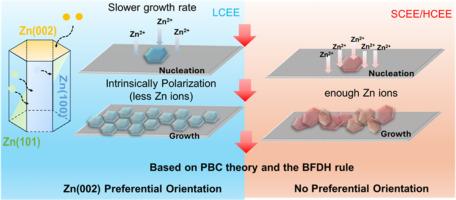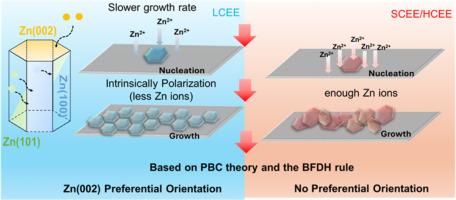化危机为机遇:本征极化低浓度共晶电解质实现了锌阳极的高度可逆性
IF 18.9
1区 材料科学
Q1 CHEMISTRY, PHYSICAL
引用次数: 0
摘要
低浓度电解质(LCE)具有低粘度、出色的润湿性和成本效益,因此在可持续能源储存方面大有可为。然而,其固有的极化问题往往会导致副反应和枝晶生长,从而阻碍其更广泛的应用。在此,我们提出了一种方法,将 LCE 固有极化的负面影响转化为优势,从而克服这些挑战。实验和理论分析表明,醋酸盐吸附锌阳极可以利用 LCE 的固有极化来引导其表面的电晶化过程。这促进了具有高稳定性的 Zn(002) 平面的优先取向,从而使装载了低浓度共晶电解质 (LCEE) 的对称电池在长达 3150 小时的无枝晶生长过程中保持了惊人的低电压极化。因此,与其他含有 LCE 的锌基电池相比,含有 LCEE 的 Zn//PANI 全电池具有更高的容量和循环稳定性。这项研究不仅实现了 LCE 的差异化设计,还为未来的电解质开发提供了明确的指导。本文章由计算机程序翻译,如有差异,请以英文原文为准。


Turning crisis into opportunity: Intrinsically polarised low concentration eutectic electrolytes enable highly reversible zinc anodes
Low-concentration electrolytes (LCEs) hold great promise for sustainable energy storage due to their low viscosity, excellent wettability, and cost-effectiveness. However, their intrinsic polarization issues often lead to side reactions and dendrite growth, hindering their broader application. Herein, we present an approach to convert the negative effects of intrinsic polarization in LCEs into advantages, overcoming these challenges. The experimental and theoretical analyses demonstrate that acetate-adsorbed zinc anodes can harness the intrinsic polarization of LCEs to direct the electrocrystallization process on their surfaces. This promotes the preferential orientation of Zn(002) plane with high stability, resulting in symmetric batteries loaded with low-concentration eutectic electrolytes (LCEE) that maintain surprisingly low voltage polarization during the dendrite-free growth of up to 3150 h. In addition, by forming an organic-inorganic composite film enriched with N and Cl, LCEE achieves rapid migration of Zn2+. This allows Zn//PANI full batteries with LCEE to demonstrate superior capacity and cycling stability compared to other Zn-based batteries with LCEs. This study not only achieves a divergent design in LCEs but also provides clear guidance for future electrolyte development.
求助全文
通过发布文献求助,成功后即可免费获取论文全文。
去求助
来源期刊

Energy Storage Materials
Materials Science-General Materials Science
CiteScore
33.00
自引率
5.90%
发文量
652
审稿时长
27 days
期刊介绍:
Energy Storage Materials is a global interdisciplinary journal dedicated to sharing scientific and technological advancements in materials and devices for advanced energy storage and related energy conversion, such as in metal-O2 batteries. The journal features comprehensive research articles, including full papers and short communications, as well as authoritative feature articles and reviews by leading experts in the field.
Energy Storage Materials covers a wide range of topics, including the synthesis, fabrication, structure, properties, performance, and technological applications of energy storage materials. Additionally, the journal explores strategies, policies, and developments in the field of energy storage materials and devices for sustainable energy.
Published papers are selected based on their scientific and technological significance, their ability to provide valuable new knowledge, and their relevance to the international research community.
 求助内容:
求助内容: 应助结果提醒方式:
应助结果提醒方式:


